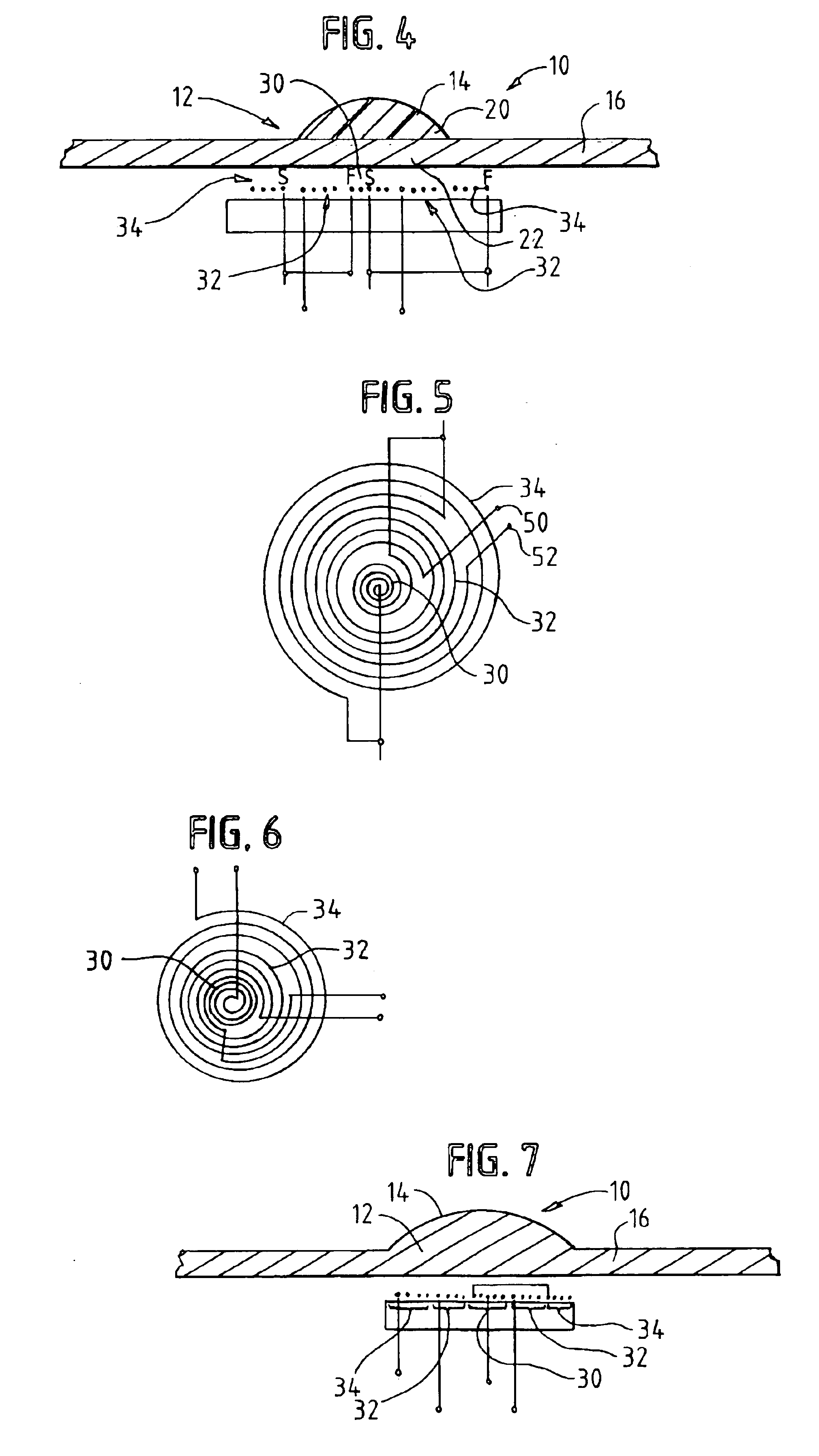Acoustic wave sensor with EMAT drive
a technology drive, which is applied in the field of acoustic wave sensor having an electromagnetic acoustic transducer, can solve the problems of metals and the like not being used, the type of switch is expensive, and the piezoelectric element is relatively unprotected
- Summary
- Abstract
- Description
- Claims
- Application Information
AI Technical Summary
Problems solved by technology
Method used
Image
Examples
first embodiment
[0027]As shown in the present invention, the EMAT 18 includes a magnet 28 and concentric, spiral primary coil 30, pickup coil 32 and noise canceling coil 34 mounted on a surface 36 of the magnet 28 spaced from the substrate 16. In this embodiment, the primary coil 30 is the inner-most coil having a drive signal applied to a lead 40 thereof. The pickup coil 32 is a spiral coil adjacent to and concentric with the primary coil 30. In this embodiment, both the primary and pickup coils 30 and 32 are directly beneath the acoustic wave cavity 12. The noise canceling coil 34 is adjacent to the pickup coil 32 and concentric with the primary and pickup coils 30 and 32; however, the acoustic wave cavity 12 does not overlie the noise canceling coil 34. In this embodiment, the outer end of the pickup coil is connected to the outer end of the noise canceling coil and the output signal of the acoustic wave sensor is the voltage between the inner or starting end of the pickup coil 32 and the starti...
second embodiment
[0028]In the present invention, as illustrated in FIGS. 4 and 5, the noise canceling coil 34 is driven 180° out of phase with the primary coil wherein the concentric primary and pickup coils 30 and 32 are directly underneath the acoustic wave cavity 12 whereas the acoustic wave cavity 12 does not overlie the noise canceling coil 34. In this embodiment, the start of the primary coil 30 is connected to the outer or finishing end of the noise canceling coil 34 and the finishing or outer end of the primary coil 30 is connected to the start or inner end of the noise canceling coil 34. The output of the acoustic wave sensor is obtained between the two ends 50 and 52 of the pickup coil, the output representing the acoustic wave energy in the cavity 12 with the spurious current induced by the primary having been cancelled.
third embodiment
[0029]In the present invention, as shown in FIGS. 6 and 7, one coil forms both the inner primary coil portion 30 and the outer noise canceling portion 34 of the EMAT wherein the pickup coil is disposed in a space between the primary portion 30 and the noise canceling portion 34 of the first coil. In this embodiment, the concentric coils are all contained underneath the acoustic wave cavity so as to provide the most compact EMAT arrangement. More particularly, the primary coil portion 30 forms an inner coil that is connected to the outer most coil portion forming the noise canceling coil portion 34. The pickup coil 32 is concentric with the primary and noise canceling portions of the first coil but is disposed in a space therebetween. The acoustic wave cavity 12 overlies all three coil portions 30, 32 and 34.
[0030]FIG. 8 illustrates one magnet configuration for the EMAT 28. In this configuration, a magnet 52 with its north pole adjacent the substrate 16 is positioned next to a magnet...
PUM
 Login to View More
Login to View More Abstract
Description
Claims
Application Information
 Login to View More
Login to View More - R&D
- Intellectual Property
- Life Sciences
- Materials
- Tech Scout
- Unparalleled Data Quality
- Higher Quality Content
- 60% Fewer Hallucinations
Browse by: Latest US Patents, China's latest patents, Technical Efficacy Thesaurus, Application Domain, Technology Topic, Popular Technical Reports.
© 2025 PatSnap. All rights reserved.Legal|Privacy policy|Modern Slavery Act Transparency Statement|Sitemap|About US| Contact US: help@patsnap.com



